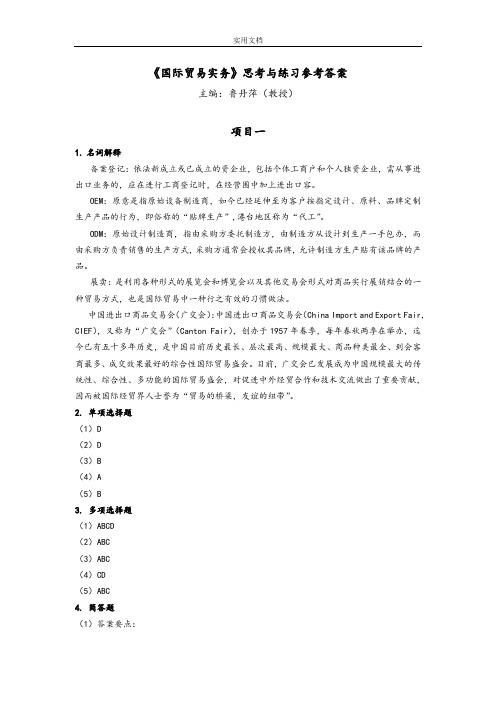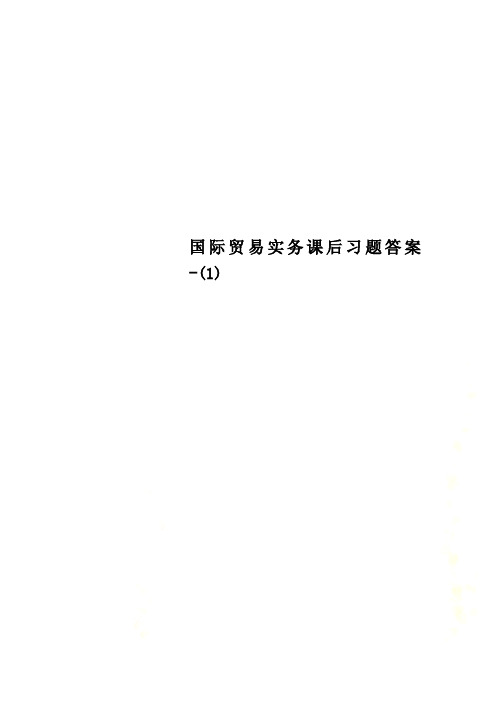国际贸易实务名词解释整理+部分课后题
- 格式:docx
- 大小:28.52 KB
- 文档页数:6

《国际贸易实务》思考与练习参考答案主编:鲁丹萍(教授)项目一1.名词解释备案登记:依法新成立或已成立的资企业,包括个体工商户和个人独资企业,需从事进出口业务的,应在进行工商登记时,在经营围中加上进出口容。
OEM:原意是指原始设备制造商,如今已经延伸至为客户按指定设计、原料、品牌定制生产产品的行为,即俗称的“贴牌生产”,港台地区称为“代工”。
ODM:原始设计制造商,指由采购方委托制造方,由制造方从设计到生产一手包办,而由采购方负责销售的生产方式,采购方通常会授权其品牌,允许制造方生产贴有该品牌的产品。
展卖:是利用各种形式的展览会和博览会以及其他交易会形式对商品实行展销结合的一种贸易方式,也是国际贸易中一种行之有效的习惯做法。
中国进出口商品交易会(广交会):中国进出口商品交易会(China Import and Export Fair, CIEF),又称为“广交会”(Canton Fair),创办于1957年春季,每年春秋两季在举办,迄今已有五十多年历史,是中国目前历史最长、层次最高、规模最大、商品种类最全、到会客商最多、成交效果最好的综合性国际贸易盛会。
目前,广交会已发展成为中国规模最大的传统性、综合性、多功能的国际贸易盛会,对促进中外经贸合作和技术交流做出了重要贡献,因而被国际经贸界人士誉为“贸易的桥梁,友谊的纽带”。
2. 单项选择题(1)D(2)D(3)B(4)A(5)B3. 多项选择题(1)ABCD(2)ABC(3)ABC(4)CD(5)ABC4. 简答题(1)答案要点:国际贸易从业人员素质要求有:①语言。
国际贸易涉及的双方一般跨越国界,因此跨越语言的障碍是从事这一职业必须具备的第一大技能。
国际贸易从业人员至少要具备英语的日常交流能力,甚至具备将英语作为工作语言的能力。
②国际贸易知识与实务操作技能。
国际贸易的操作较之国贸易,涉及面广、环节众多、不仅受国政策影响,也受国际经济形势及贸易对象所在国政策的影响,相当复杂。

第五章国际贸易商品价格一、名词解释1、所谓差价:是指同一种商品由于交易条件的不同而产生的价格上的差异。
2、出口换汇成本:是指某商品出口净收入一个单位的外汇所需要的人民币成本,它是衡量外贸企业和进出口交易盈亏的重要指标。
它与外汇牌价进行比较能直接反映出商品出口是否盈利。
出口换汇成本的计算公式为:出口换汇成本=出口总成本(人民币)/出口外汇净收入(外汇)。
3、出口盈亏率:是指盈亏额与出口总成本的比例,用百分比表示,它是衡量出口盈亏程度的一项重要指标,其计算公式如下:出口盈亏率=(出口销售人民币净收入-出口总成本)/出口总成本×100%。
4、佣金:是代理人或经纪人为委托人介绍买卖或提供其他服务而取得的报酬。
5、折扣:是卖方给予买方的一种价格减让。
6、出口创汇率,又称外汇增值率,是指加工后成品出口的外汇净收入与原料外汇成本的比率。
该指标主要用于计算用国外原材料或国产原材料加工再出口的业务。
其计算公式如下:出口创汇率= (成品出口外汇净收入-原料外汇成本)/原料外汇成本×100%。
二、选择题1.佣金额是在( B )的基础上计算的。
A.净价B.含佣价C.折扣D.原价2.在国际贸易中佣金应付给( C )。
A.收货人B.发货人C.中间商D.委托人3.国际货物贸易的作价方法很多,其中最常见常用的是( B )。
A.暂定价格B.固定价格C.待定价格D.先确定初步价格,然后按原材料价格指数和工资指数最后调整三、判断题(×)1.出口总成本是指该商品的进货成本加上出口前的一切费用和税金。
(√ )2.出口换汇成本与出口总成本成正比。
(√)3.出口换汇成本与外汇净收入成反比。
(√)4.折扣一般是在买方支付货款时从货款中预先扣除。
(× )5.在市场价格瞬息万变而对市场价格变化趋势看不准的情况下,为了避免承担价格变动的风险,应采用固定价格的作价办法。
(√)6.采用非固定价格比较灵活,有利于避免在市场价格变化时给交易带来的不稳定性。

国际贸易实务名词解释及问答题第一篇:国际贸易实务名词解释及问答题溢短装条款又称数量机动幅度条款,即在买卖合同的数量条款中明确规定可以增减的百分比,但增减的幅度以不超过规定的数量的百分比为限。
唛头运输标志习称唛头,通常是由一个简单的几何图形和一些字母、数字及简单的文字组成。
中性包装中性包装是既不标明生产国别、地名和厂商名称,也不标明商标或品牌的包装。
清洁提单指货物在装船时“表面状况良好”,承运人在提单没有标明货物及/或包装有缺陷状况的条款或批注的提单。
信用证信用证是指由银行(开证行)依照客户(申请人)的要求和指示或自己主动,开立一张以出口商为受益人的有条件的承诺付款的书面文件。
信用证是由银行开立的有条件承诺付款的书面文件。
共同海损载货船舶在海运上遇难时,船方为了共同安全,以使同一航程中的船货脱离危险,有意而合理地作出的牺牲或引起的特殊费用,这些损失和费用被称为共同海损。
在海洋运输途中,船舶、货物或其他财产遭遇共同危险,为了解除共同危险,有意采取合理的救难措施,所直接造成的特殊牺牲和支付的特殊费用,称为共同海损。
不可抗力合同签订后,发生了当事人无法预见、无法预防和无法控制的意外事件,致使合同不能履行,可以免除当事人的责任。
仲裁仲裁一般是当事人根据他们之间订立的仲裁协议,自愿将其争议提交由非官方身份的仲裁员组成的仲裁庭进行裁判,并受该裁判约束的一种制度。
补偿贸易补偿贸易是指在信贷基础上进口设备,然后以回销产品和劳务所得价款,分期偿还进口设备的价款及利息。
仓至仓条款即保险责任自被保险货物远离保险单所载明的起运地仓库或储存处所开始,包括正常运输中的海上、陆上、内河和驳船运输在内,直至该项货物运抵保险单所载明的目的地收货人的最后仓库或储存处所或被保险人用作分配、分派或非正常运输的其他储存处所为止。
过期提单这是指错过规定的交单日期或者晚于货物到达目的港日期的提单。
按照(ucp600)规定,凡超过发运日期21个日历日后提交的提单为过期提单。

国际贸易实务考试习题集精解国际贸易习题精解一、名词解释1 ?差价:是指同一种商品由于交易条件的不同而产生的价格上的差异。
2. 岀口换汇成本:是指某商品岀口净收入一个单位的外汇所需要的人民币成本,它是衡量外贸企业和进岀口交易盈亏的重要指标。
它与外汇牌价进行比较能直接反映岀商品岀口是否盈利。
岀口换汇成本的计算公式为:岀口换汇成本=出口总成本(人民币”出口外汇净收入(外汇)。
3. 岀口盈亏率:是指盈亏额与岀口总成本的比例,用百分比表示,它是衡量岀口盈亏程度的一项重要指标,其计算公式如下:出口盈亏率=(出口销售人民币净收入一出口总成本)/出口总成本X100%。
4. 佣金:是代理人或经纪人为委托人介绍买卖或提供其他服务而取得的报酬。
5. 折扣:是卖方给予买方的一种价格减让。
6. 岀口创汇率,又称外汇增值率,是指加工后成品岀口的外汇净收入与原料外汇成本的比率。
该指标主要用于计算用国外原材料或国产原材料加工再出口的业务。
其计算公式如下:出口创汇率=(成品出口外汇净收入-原料外汇成本)/原料外汇成本X100%。
二、选择题1. 佣金额是在(B )的基础上计算的。
A ?净价B ?含佣价C.折扣D.原价2?在国际贸易中佣金应付给(C )。
A ?收货人B ?发货人C.中间商D ?委托人3?国际货物贸易的作价方法很多,其中最常见常用的是(B)。
A ?暂定价格B ?固定价格C.待定价格D ?先确定初步价格,然后按原材料价格指数和工资指数最后调整1、在国际贸易中,含佣价的计算公式是()。
A、单价X佣金率B、含佣价X佣金率C、净价x佣金率D、净价/ (1-佣金率)2、凡货价中不包含佣金和折扣的被称为()。
A、折扣价B、含佣价C、净价D、出厂价3、一笔业务中,若岀口销售人民币净收入与岀口总成本的差额为正数,说明该笔业务为()。
A、盈B、亏C、平D、可能盈、可能亏4、()是含佣价。
A、FOBSB、FOBTC、FOBCD、FOB5、在我国进岀口业务中,计价货币选择应()。

国际贸易实务课后习题答案-(1)第一章货物的品质和数量一、名词解释(略)二、填空题1.文字说明、样品2.规格、等级、标准、牌号3.良好平均品质、上好可销品质4.溢短装百分比、机动幅度的选择权和溢短部分的计价方法5.重量单位、容积单位、个数单位、长度单位、面积单位、体积单位6.公制、美制、英制、国际单位制7.按实际皮重、按平均皮重、按约定皮重、按习惯皮重三、选择题1.C2.C3.C4.C5.B6.B7.C四、判断题1.×2.√3.×4.×5.√6.×五、问答题1.答:主要有:按货物的主要用途命名、按货物的主要原材料命名、按货物的主要成分命名、按货物的外观造型命名、使用褒义词命名、以人物名字命名、按货物的制作工艺命名。
2.答:品名条款必须明确、具体规定货物的名称;适合货物的特点;采用外文名称时,要做到译名准确,与原名意思一致,避免含糊不清或过于空洞。
3.答:国际货物买卖的交易双方首先必须在合同中明确规定货物的名称,才能进一步确定货物的质量。
而货物的质量不仅关系到价格的高低、销售数量,而且直接关系到买卖双方的利益。
因此,品质条款是国际货物买卖合同中的重要内容。
4.答:表示货物品质的方法有多种,具体包括:文字说明和样品。
其中,文字说明的方法主要有规格、等级、标准、商标或牌号、产地等。
在使用是应该根据货物的特点、市场习惯、实际需要和交易的具体情况选用。
5.答:合同中规定数量机动幅度一般使用溢短装条款,多装或少装数量的价款在合同中作相应的规定。
6.答:国际贸易中重量的规定方法有:毛重、净重、公量、理论重量、法定重量等。
7.答:有区别。
《跟单信用证统一惯例》规定,About表明数量可有上下10%的伸缩,因此,“About 500m/t”的交货数量可在450-550m/t之间,而“500m/t 5% more or less at seller’s option”卖方最多可交525m/t,最少可交475m/t,多交或少交部分一般按合同价格计价。

第二章国际贸易交易前的准备一、名词解释1、国际商品市场调研:是指为了发现一种或一组产品的销售趋势,找出取得销售成功的方法而进行的调查国际商品市场的活动。
它不仅是市场状况和统计数字的罗列,而且还要对它们进行全面分析与研究,为企业的营销与经营管理提供科学决策。
2、直接出口:是指生产企业不通过中间人,而自己直接从事一切出口营销活动。
在直接出口方式下,企业的一系列重要业务活动都是由其自身完成的。
3、间接出口:是指企业将产甜卖给国内的岀口商或委托国内的外贸代理机构,由他们负责经营出口业务。
4、海外生产:是指在目标市场国家或地区就地生产、就地销售。
它也是企业走向国际市场的一条非常重要及有效的渠道。
5、出口商品经营方案:是对外洽商交易、推销商品和安排出口业务的依据。
其主要内容大致包括下列几方而:货源情况、国外市场情况、出口经营情况、推销计划和措施等。
6、国际注册商标:是指企业通过马德里协定和议定书办理商标国际注册。
7、商标国际注册体系:在商标国际注册体系中,主要有两个条约:一是《商标国际注册马徳里协定》,简称马徳里协定;另一是《商标国际注册马徳里协定有关议定书》,简称马德里议定书。
它们共同组成商标国际注册的马德里联盟。
二、简答题1、在进行国际贸易Z前,为什么要进行国际市场调研?国际市场调研包括哪些内容?答:国际商品市场是世界各国之间商品流通与交换的场所。
由于它与国内商品市场在构成、变动规律、市场环境和交换方式等方面的差界,任何企业若要参与国际商品市场营销活动并期望得到成功,就必须首先要进行国阪商品市场调研。
国际商品市场调研的内容比较广泛,归纳起来有两类:国际商品市场环境调研和国际商品市场行情调研。
国际商品市场环境调研通常包括政治环境、经济环境、文化环境、地理环境以及竞争环境等的调研;国际商品市场行情调研的内容主要包括市场营销活动的各个方面。
它概括有以下几方面:出口商品生产的调研、出口商品消费调研、国际商品市场需求潜力的调研、商品价格调研、营销方式调研和商品销售渠道调研等。
习题集第一章贸易术语及商品的价格一、名词解释1.贸易术语:又称贸易条件、价格术语,用以说明价格的构成及买卖双方有关费用的划分,以确定买卖双方在交货和接货过程中应尽的义务2.《INCOTERMS 2000》:国际贸易术语解释通则的宗旨是为国际贸易中最普遍使用的贸易术语提供一套解释的国际规则,以避免因各国不同解释而出现的不确定性,或者少在相当程度上减少这种不确定性3.国际贸易惯例:指在国际贸易实践中逐渐自发形成的,某一地区、某一行业中普遍接受和经常遵守的任意行为规范4.EDI:电子数据交换,是指将商业或行政事务按一个公认的标准,形成结构化的事务处理或文档数据格式,以及从计算机到计算机的电子传输方式。
5.FOBST:6.佣金7.装船通知 8.象征性交货二、填空题1.有关贸易术语的国际惯例有、、。
2.《2000通则》中,由买方办理出口手续的术语是、,而由卖方办理进口手续的术语是、。
3.《2000通则》中,仅适于水上运输的术语有、、、、、;适于各种运输方式的术语有、、、、、、。
4.FOB的变形主要是为了明确费用的负担,而CIF和CFR的变形主要是为了明确费用的负担。
5.国际贸易中,商品的单价由以下四部分内容组成:、、和。
例如:。
三、判断题()1.以CIF Ex ship’s Hold New York条件成交,卖方应负担从培育运港到纽约为止的费用和风险。
()2.以CIF班轮条件成交,卖方必须用班轮装运货物。
()3.以FOB吊钩下交货成交,卖方只须将货置于吊钩下,即完成交货义务,以后发生的风险概不负责。
()4.以FCA条件成交,卖方将货物交给承运人后,即履行完交货义务,出口报关等手续由买方办理。
()5.以DES条件成交,货到目的港后的进口报关手续应由买方办理。
()6.FCA、CPT、CIP三术语的风险划分点是一样的。
()7.CIF Landed意味着卖方要承担货物运到目的港的一切费用,包括卸货费。
()8.为避免货物中途转船延误时间,增大费用开支,造成货损货差,我方按FOB条件进口时,最好争取在合同中规定“不准转船”。
第五章合同的标的物及其质量、数量与包装一、名词解释题1.看货买卖若买卖双方根据成交商品的实际品质进行交易,通常是由先由买方或其代理人在卖方所在地验看货物,达成交易后,卖方即应按验看过的商品交付货物。
2.凭卖方样品买卖由卖方提供的样品称为“卖方样品”。
凡凭卖方样品作为交货的品质依据者,称为“凭卖方样品买卖”。
3.凭买方样品买卖买方为了使其订购的商品符合自身要求,有时也提供样品交由卖方依样承制,如卖方同意按买方提供的样品成交,称为“凭买方样品买卖”。
4.对等样品卖方根据买方提供的样品,加工复制出一个类似的样品交买方确认,这种经确认后的样品,成为“对等样品”或“回样”,也可称之为“确认样品”。
5.品质公差是指国际上公认的产品品质的误差。
6.复样向买方送交样品时,卖方应留存的一份或数份同样的样品。
(也称留样)7.品质机动幅度某些初级产品的质量不稳定,为了交易的顺利进行,在规定其品质指标的同时,可另订一定的品质机动幅度,即允许卖方所交货物的品质指标在一定幅度内有灵活性。
8.溢短装条款又称数量机动幅度条款或数量增减条款,是买卖双方在合同中合理规定数量机动幅度的条款。
9.公量以商品的干净重(指烘去商品水分后的重量)加上国际公定回潮率与干净重的乘积所得出的重量。
10.以毛作净以毛重当作净重计价。
11. 运输标志这种标志又称唛头,通常是由一个简单的几何图形和一些字母、数字及简单的文字组成。
其主要内容包括:目的地的名称或代号;收、发货人的代号;件号、批号。
12. 定牌定牌是指卖方按买方要求在其出售的商品或包装上标明买方指定的商标或品牌,这种做法叫做定牌生产。
13. 中性包装中性包装是指既不标明生产国别、地名和厂商的名称,也不标明商品或牌号的包装。
采用中性包装,是为了打破某些进口国家与地区的关税和非关税壁垒以及适应交易的特殊需要,它是出口国家厂商加强对外竞销和扩大出口的一种手段。
14.无牌中性包装是指包装上既无生产地名和厂商名称,又无商标、品牌。
《国际贸易学》第一章国际贸易学的研究一、名词解释1、净进口:将某种商品的出口数量和进口数量相比较,出口量小于进口量净出口:出口量大于进口量2、总贸易:总进口加上总出口就是一国的总贸易额。
总贸易包括所有进出入该国的商品,主要反映一国在国际商品流通中所处的地位。
专门贸易:专门进口额加上专门出口额就是一国的专门贸易额。
专门贸易额只包括那些进口是用于该国生产和消费的商品,出口是由该国生产和制造的商品,主要反应一国作为生产者和消费者在国际贸易中起的作用。
6、国际贸易商品结构:指各类商品在国际贸易中所处的地位,通常以它们在世界出口总额中的比重来表示。
二、思考题1、什么是国际贸易?它与国内贸易有什么区别?国际贸易量的计算1)国际贸易:指世界各国(或地区)之间在商品和服务方面的交换活动它是各个国家(或地区)在国际分工的基础上相互联系的主要形式。
2)3)2、什么是贸易差额?它与一国的经济发展有什么关系?1)在一定时期内(通常为一年)一个国家的出口总值与进口总值之间的差额,称为贸易差额2)贸易差额是衡量一国对外贸易状况的重要指标。
一般贸易顺差表明一国在对外贸易收支上处于有利地位,贸易逆差则表明一国在对外贸易收支上处于不利境地。
但是长期保持顺差也不一定是好事。
巨额顺差还会影响国内货币政策对一国经济的调控能力。
3、什么是国际贸易地理方向?如何正确看待国际贸易地理方向的集中与分散?1)国际贸易地理方向又称国际贸易地区分布,用来表明世界各个地区或各个国家在国际贸易中所占的地位,通常使用它们的出口贸易额(进口贸易额)占世界出口贸易额(进口贸易额)的比重来表示。
相对于某一个国家或地区来说,它就是对外贸易地理方向,表明一个国家或地区进口商品的来源和出口商品的去向,从而反映该国与其他国家或地区之间的经济贸易联系程度。
2)对外贸易地理方向的集中和分散各有优劣。
集中有利于信息的交流、扩大出口国商品在进口国的影响,但无论对进口还是出口而言,一国对外贸易地理方向过于集中,都会使该国容易受制于人,从而在对外贸易中处于不利境地。
第十一章进出口合同的履行一、名词解释1、备货就是根据出口合同的规定,按时、按质、按量准备好应交付的货物,以保证按时出运,如约履行。
备货工作的内容,大致包括:卖方或者向有关生产部门(或仓储部门)安排准备出运货物;或者向国内供货人订立采购货物合同和催交货物。
2、审证是指当国外买方开来信用证时,卖方对开证行的背景和资信能力以及信用证的内容进行认真审查和核对。
3、出口报关:出口货物在装船出运之前,需向海关办理报关手续,出口货物办理报关时必须填写出口货物报关单,必要时还需要提供出口合同副本,发票,装箱单,重量单,商品检验证书和其他有关证件,海关查验有关单据后,即在装货单上盖章放行,凭以装船出口。
4、制单结汇是指出口货物装运后,有关公司、企业按照合同或信用证的规定,正确缮制各种单据,持单向当地银行结汇,即出口商通过银行收取货款。
5、收妥结汇:是指议付行收到外贸公司的单据后,经审查无误,将单据寄交外国付款行索取货款,待收到付款行将货款拨入议付行账户的贷记通知书时,即按当日外汇牌价,折成人民币给外贸公司。
6、押汇:又称买单结汇,是指议付行收到单据在审查无误情况下,按信用证的条款买入受益人(外贸公司)的汇票和单据,从票面金额中扣除从议付日到估计收到货款日的利息,将余款按议付日外汇牌价折算成人民币,拨交外贸公司。
议付行向受益人垫付资金买入跟单汇票后,即成为汇票持有人,可凭票向付款行索取票款。
银行做出口押汇,是为了对外贸公司提供资金融通,有利于外贸公司的资金周转。
7、定期结汇:是议付行根据向国外付款行索偿所需时间,预先确定一个固定的结汇期限,到期后主动将票款金额折成人民币拨交外贸公司。
8、商业发票:是出口商开给进口商的收货清单,是出口商结汇所需的单据之一,是进口商凭以收货、付款以及报关纳税的依据。
缮制其他单证一般要以发票为依据。
9、普惠制单据:是根据普惠制给惠国的原产地规则和有关要求,由普惠制受惠国授权机构出具的具有法律效力的证明文件。
International TradeDefinition of important terms:1. Trade bloc 贸易集团▪ An intergovernmental association of a large free trade area formed by one or more tax, tariff, and trade agreements, which manages and promotes trade activities for ▪specific region of the world.▪ Freely, or cheaply for members ▪ Barriers against non-members2. Non-tariff barrier 非关税壁垒A non-tariff barrier to import is any policy used by the government to reduce imports, other than a simple tariff on imports.3. CommodityCommodity is the article of commerce of any kind that is for sale – goods, merchandise or product.4. CIF/CFR/FOB 到岸价/ 成本+运费/ 离岸价CIF: Cost Insurance and Freight (named port of destination)CFR: Cost and Freight (named port of destination)FOB: Free On Board (named port of shipment)5. L/C见176. F.A.Q. 平均良好品质(Fair Average Quality) not particular quality specification but average quality of the current group, recent shipment.7. General average共同海损Loss or damage to a ship or its cargo that is shared among the shipowner and all the cargo owners.8. Constructive total loss(推定全损)may occur if the cargo is NOT actually lost, but is so seriously damaged as to make the goods no longer useful for the purpose for which they were originally intended.9. Neutral packing 中性包装Do not mention the name of the country producing the goods and the name of the manufacturer on the commodity and on the outer and inner packages.10. Liner 班轮The liners run fixed schedules, follow fixed routes and charge standard rates called conference rates.11. Break-even Point 收支平衡点(BEP) is the point where revenues from sales equal all costs.12. Dumping 倾销Dumping is the practice of selling products in foreign country at lower prices than those charged in the producing country13. Bill of Exchange (Draft) 汇票a written order to pay a sum of money to a particular person on a particular date. Drafts are negotiable and may be sold.14. Remittance 汇付Transfer of funds from one party to another among different countries through banks.15. D/P 付款交单Documents Against PaymentUnder D/P, the buyer can receive the shipping documents only after he has duly made the payment of the goods.16. D/A 承兑交单Documents Against AcceptanceUnder D/A, the buyer can receive the shipping documents from the collecting bank after he has duly accepted the draft.17. Letter of Credita letter from a bank that allows you to get a particular amount of money from another bank18. Collection 托收Presentation for payment of an obligation and the payment thereof19. Force Majeure 不可抗力unexpected circumstances, such as war, that can be used as an excuse when they prevent sb from doing sth that is written in a contract20. Arbitration 仲裁Arbitration is the judging of a dispute between people or groups by someone who is not involved.21. Counter-offer 还盘A counter-offer is an offer that someone makes, for example, for a house or business, in response to an offer by another person or group.22. Pro forma Invoice 形式发票A document provided prior to or with a shipment of goods (as for export) that describes the items and terms of sale but dose not have the function of a real invoice.23. Forwarder (Shipping agency) 货代A person or organization that dispatches or delivers goodsOne that forwards; especially an agent who performs services (as receiving, transshipping, or delivering) designed to move goods to their destination.Chapter5 选择A. 单选1. The term CIF should be followed by .a. point of originb. port of shipmentc. port of destinationd. port of exportation2. The term FOB should be followed by .a. point of originb. port of importationc. port of discharged. port of exportation3. The term EXW should be followed by .a. point of originb. port of shipmentc. port of importationd. port of exportation4. The term DAT should be followed by .a. point of originb. port of loadingc. port of destinationd. port of shipment5. The term FAS should be followed by .a. point of originb. port of destinationc. port of shipmentd. port of exportation6. The term CFR should be followed by .a. point of originb. port of shipmentc. port of destinationd. port of exportation7. The term DDP should be followed by .a. point of originb. port of shipmentc. port of premised. place of destination8. The term DAP should be followed by .a. point of originb. place of importationc. port of exportationd. port of shipment9. The term FCA should be followed by .a. seller's railway stationb. point of originc. seller's place of shipmentd. buyer's railway stationB. 多选Which of the following are included in the quoted price?1. The quoted price for 3 red zoom roadsters is US $ 6,000 Ex-works, Beijing.a. 3 red zoom roadstersb. freight to dockc. loading chargesd. ocean freightere. marine insurancef. unloading2. The quoted price for 12 “Butterfly” sewing machines is US $ 700 FAS, Dalian.a. 12 “Butterfly” sewing machinesb. freight to dockc. loading chargesd. ocean freighte. marine insurancef. unloading3. The quoted price for 1,000 “Panda” radios is US $10,000 CFR, Tianjin.a.1,000 “Panda” radiosb. freight to dockc. loading chargesd. ocean freighte. marine insurancef. unloading4. The quoted price for 100 pairs of shoes is US $3,000 FOB, Shanghai.a.100 pairs of shoesb. freight to dockc. loadingd. unloadinge. import duties5. The quoted price for 1 tractor is $ 5,000 CIF, Hong Kong.a.1 tractorb. transportation to dockc. loadingd. export chargese. ocean freightf. marine insuranceg. unloadingh. import dutiesChapter 6(B)mineral ore A. sample(C)ordinary garments B. manual(D)fish C. F.A.Q(E)Haier washing machines D. G.M.Q(G)medical apparatus E. famous brand(A)wheat F. specification(H)calligraphic works G. inspection(F)power plant generator H. drawing or diagramChapter 7 判断1. Under FOB, the seller must give the buyer prompt shipping advice as the goods are shipped on board the vessel.2. Demurrage is the extra charges a shipper pays for detaining a freight car or ship beyond time permitted for loading or unloading.3. Dispatch money is a fine imposed on the charter for the delay in the loading and unloading of the goods.4. Unclean B/L can be negotiated and accepted by the buyer and bank.5. A bill of lading is both a receipt for merchandise and a contract to deliver it as freight.6. Order B/L can be transferred with or without endorsement.Chapter 8判断1. In ocean marine insurance, the assured can recover more than actual loss provided that he can provide evidence of further losses contingent on the actual loss.2. In ocean marine insurance, general average is to be borne by the carrier, who may, upon presentation of evidence of the loss,' recover the loss from the insurance underwriter.3. Partial loss or damage is never recoverable with FPA.4. Special additional coverages such as war risk, strikes and so on must be taken out together with FPA and WPA.5. In essence, open policy is the same as the insurance certificate.6. Ocean marine insurance covers ships and their cargo only on the high seas and not on inland waterways.7. Without insurance, international trade is simply impossible to take place.8. Three types of risks are covered by ocean marine insurance, namely the perils of sea, the extraneous risks and the force majeure.9. Ocean marine insurance covers two types of losses, partial loss and total loss.Chapter 10Suppose a contract for the amount of US $ 845, 000 was approved for buyer' s credit up to 80% of the said amount. After disbursement, Bank of China, Head Office, Beijing would issue apromissory note on July 2, 2003 specifying that it is payable at 3 years after the above stated date to the order of Bank of Oslo, Oslo, Norway the sum of 80% of US $ 845, 000 (refundment of loan). Please make a promissory note by filling in the blanks of the following form.Promissory NoteIssued in Beijing the 2nd day of July, 2003On the 2nd day of July, 2006 fixed.We promise to pay against this Promissory Note to the order of Bank of Oslo,Norway the sum of USD 676000 (say Six Hundred and Seventy Six Thousand only). Payable in Oslo,Norway.For Bank of ChinaSignatureChapter 11ExampleEnquiry: 询盘Oct. 08th, 2015 (Enquiry)Dear Sir/Madam, we're interested in TV set model XXX. Please send us a firm offer at a favarable price.Offer: 发盘Oct 10th, 2015 (Firm Offer)Thanks for your inquiry dated Oct. 8th. We offer subject to your reply reaching us by Oct. 20th as follows: TV set model XXX, 1000 sets, packed in export cartons of one set each, shipped in 1X20' container, USD150 per set CFR Karachi, shipment before Dec. 31, 2015, Payment by Irrevocable Sight Credit.Counter-offer: 还盘Oct 13th, 2015 (Counter-offer)Referring to your e-mail of Oct. 10th, we regret to note that the price you offered is too high. We counter-offer USD130 per set CFR Karachi.Oct 16th, 2015 (Counter-offer of counter-offer)Your e-mail of 13th to hand. The best we can do is USD140 subject to your reply to us Oct. 22nd.Acceptance:Oct 16th, 2015 (Counter-offer of counter-offer)Your e-mail of 13th to hand. The best we can do is USD140 subject to your reply to us Oct. 22nd.。